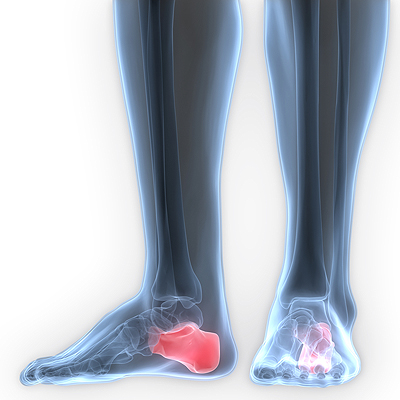
Wilmington (937) 382-2347
Fax
(513) 932-1606

Wilmington (937) 382-2347
Fax
(513) 932-1606
 There are seven bones in the foot that are referred to as tarsal bones. The cuboid bone is included in this group, and it is located on the outside of the foot. An injury can cause the ligaments surrounding this bone to become inflamed, and this is known as cuboid syndrome. It can be a common injury among athletes, and can cause considerable pain and discomfort. It may happen as a result of frequently running for extended periods of time, or from medical conditions that can include flat feet. Recovery may often begin with eliminating the activity that caused the injury, followed by elevating the foot, which may help to reduce existing swelling. Some patients may find mild relief when the affected foot is taped, as this may offer additional stability as the healing process takes place. If you feel you may have cuboid’s syndrome, please consult with a podiatrist who can properly diagnose and treat this condition.
There are seven bones in the foot that are referred to as tarsal bones. The cuboid bone is included in this group, and it is located on the outside of the foot. An injury can cause the ligaments surrounding this bone to become inflamed, and this is known as cuboid syndrome. It can be a common injury among athletes, and can cause considerable pain and discomfort. It may happen as a result of frequently running for extended periods of time, or from medical conditions that can include flat feet. Recovery may often begin with eliminating the activity that caused the injury, followed by elevating the foot, which may help to reduce existing swelling. Some patients may find mild relief when the affected foot is taped, as this may offer additional stability as the healing process takes place. If you feel you may have cuboid’s syndrome, please consult with a podiatrist who can properly diagnose and treat this condition.
Cuboid syndrome, also known as cuboid subluxation, occurs when the joints and ligaments near the cuboid bone in the foot become torn. If you have cuboid syndrome, consult with Dr. Gerald Perelman from Ohio. Our doctor will assess your condition and provide you with quality foot and ankle treatment.
Cuboid syndrome is a common cause of lateral foot pain, which is pain on the outside of the foot. The condition may happen suddenly due to an ankle sprain, or it may develop slowly overtime from repetitive tension through the bone and surrounding structures.
Causes
The most common causes of cuboid syndrome include:
Symptoms
A common symptom of cuboid syndrome is pain along the outside of the foot which can be felt in the ankle and toes. This pain may create walking difficulties and may cause those with the condition to walk with a limp.
Diagnosis
Diagnosis of cuboid syndrome is often difficult, and it is often misdiagnosed. X-rays, MRIs and CT scans often fail to properly show the cuboid subluxation. Although there isn’t a specific test used to diagnose cuboid syndrome, your podiatrist will usually check if pain is felt while pressing firmly on the cuboid bone of your foot.
Treatment
Just as the range of causes varies widely, so do treatments. Some more common treatments are ice therapy, rest, exercise, taping, and orthotics.
If you have any questions, please feel free to contact our office located in Wilmington, OH . We offer the newest diagnostic and treatment technologies for all your foot care needs.